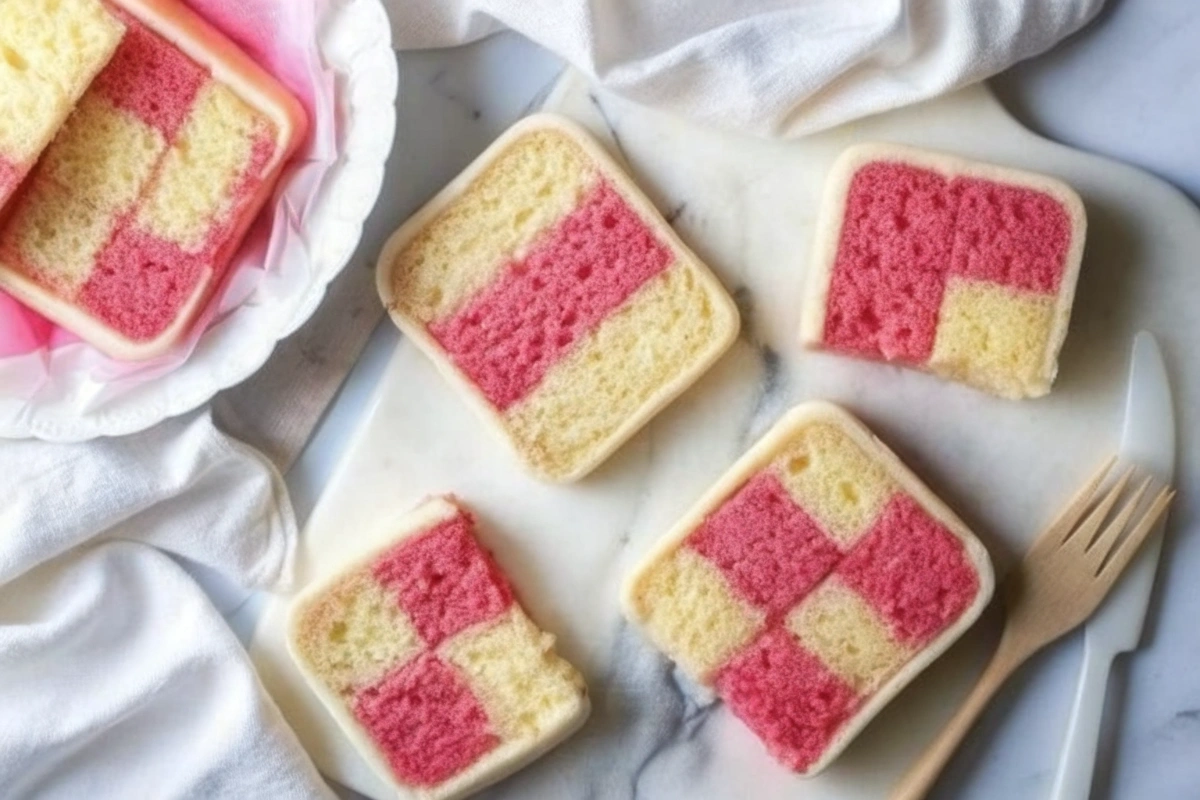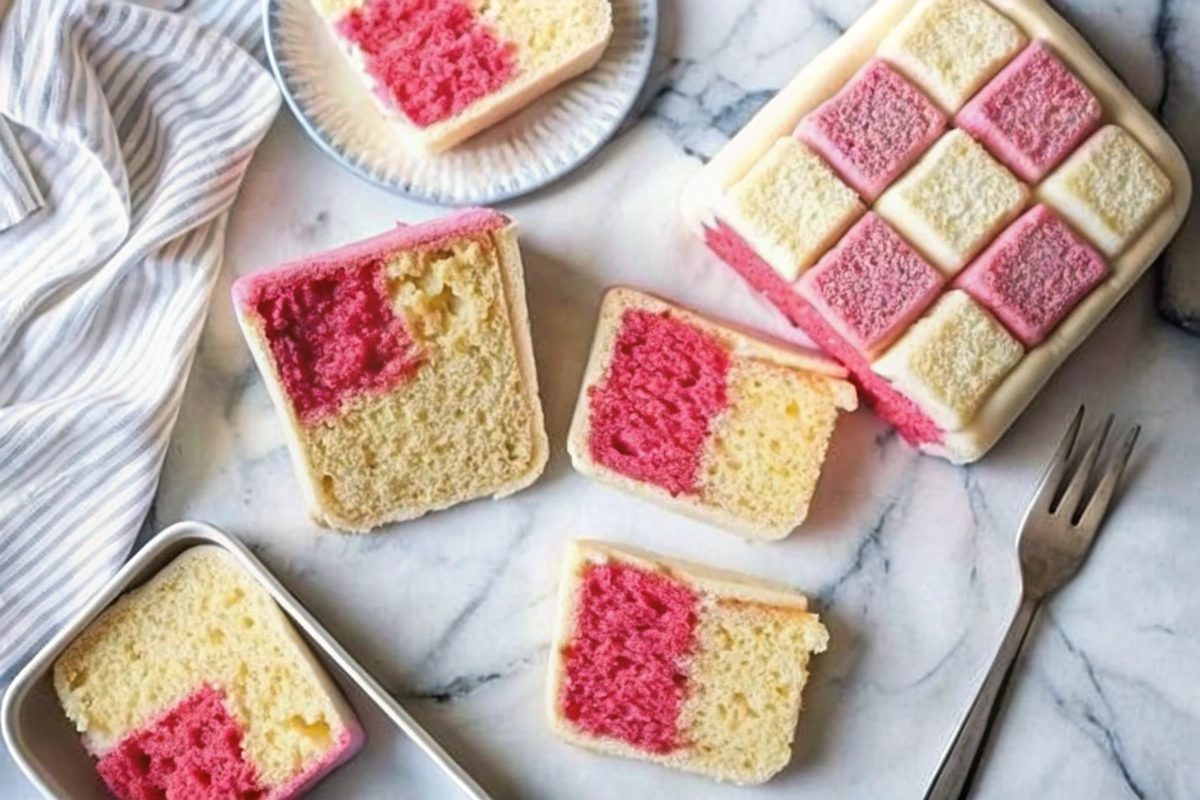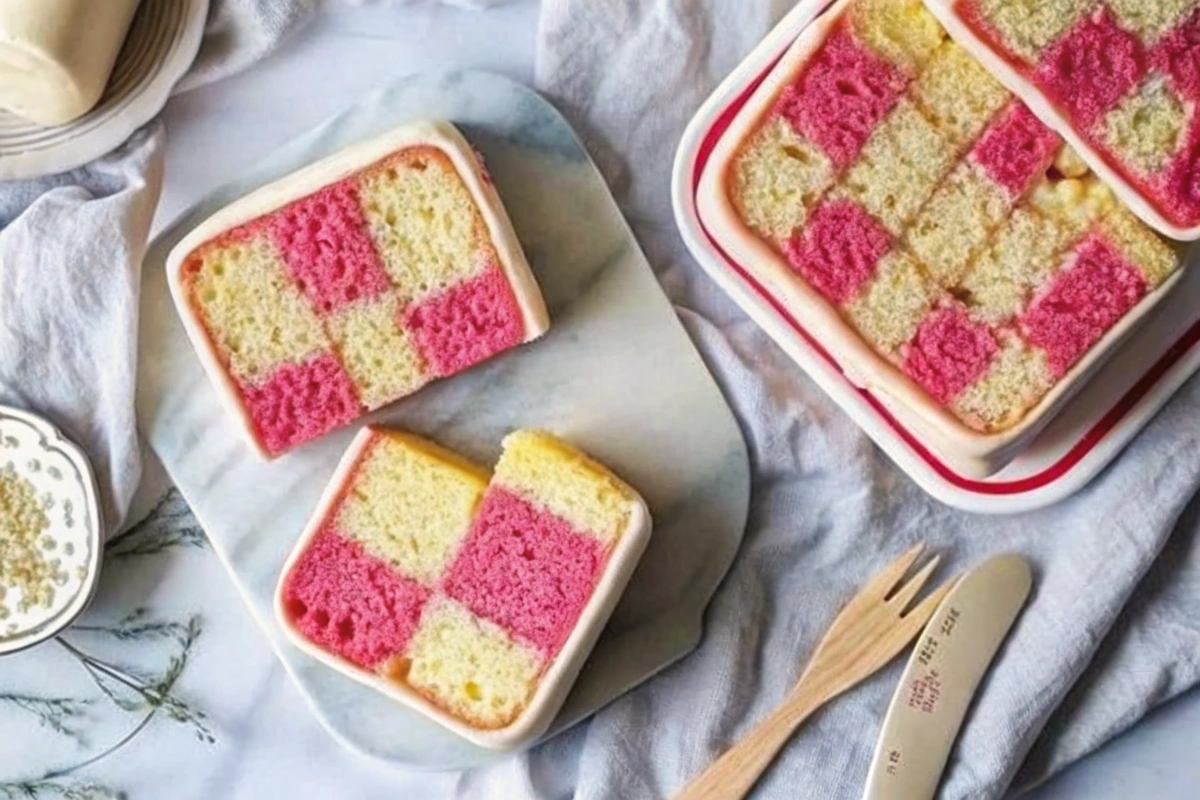Table of Contents: Vegan Battenberg Cake
Vegan Battenberg Cake
There’s something undeniably nostalgic and elegant about a Vegan Battenberg Cake—its delicate checkerboard pattern encased in golden marzipan is the ultimate centerpiece for afternoon tea, holiday gatherings, or a cozy weekend baking project. For those aged 40–65+ who grew up with this British classic but now follow a plant-based lifestyle, this recipe delivers all the charm, texture, and taste—without a single egg or dash of dairy. Whether you’re celebrating Easter, Mother’s Day, or simply want to impress guests at a family dinner, this Plant-based Battenberg is a show-stopper that proves vegan baking can be both beautiful and deeply satisfying.
Introduction: Vegan Battenberg Cake
The Vegan Battenberg Cake is a true ode to tradition and innovation. Originally invented in the 19th century to celebrate royal weddings, the classic Battenberg cake—with its signature pink-and-gold checkerboard baked in marzipan—is now reborn as a Marzipan cake vegan favorite. This recipe swaps out animal-based ingredients for plant-powered alternatives that don’t compromise on moisture, flavor, or structure. The result? A tender crumb, moist layers, and a glossy marzipan shell that’s entirely plant-based.
Perfect for afternoon tea, birthday brunches, or even as a thoughtful holiday gift, this Checkerboard cake vegan version honors heritage while embracing modern values. Whether you’re vegan, vegetarian, or just curious, you’ll love how every bite delivers almond-rich notes, a touch of sweetness, and that iconic visual delight. No special skills? No problem—this recipe is designed with beginners in mind, yet still wows seasoned bakers.
Alternate Names & Variations
You might know this delightful treat under other names or similar baked goods:
– Plant-based Battenberg (a popular Google search term)
– Marzipan cake vegan (commonly used by those avoiding animal products)
– Vegan checkerboard sponge cake
– Dairy-free Battenberg cake
– Eggless Battenberg with marzipan
This recipe also shares DNA with other two-tone sponge cakes, like Victorian sandwich cakes or checkerboard birthday cakes. If you’re hunting for a Checkerboard cake vegan that’s easy to assemble and free from animal ingredients, this is your new go-to.
Ingredients: Vegan Battenberg Cake

Vegan Battenberg Cake
Here’s everything you’ll need to create a stunning, Plant-based Battenberg—no compromises on taste or tradition:
Cake:
- – 275 g (2 ¼ cups) high-quality self-raising flour, sifted
- – 220 g (1 cup) fine caster (superfine) sugar, for ultra-tender crumb
- – 80 g (⅔ cup) finely ground almonds (or almond meal), adds richness and structure
- – 1 ¼ tsp aluminum-free baking powder
- – ¼ tsp fine sea salt, enhances flavor contrast
- – 190 g (⅔ cup + 2 Tbsp) vegan block butter (such as Naturli Vegan Block or Stork Baking Block), melted and slightly cooled
- – 190 ml (⅔ cup + 2 Tbsp) unsweetened soy milk, room temperature (best for stability)
- – 1 ½ tsp pure vanilla extract
- – ¾ tsp almond extract, essential for authentic marzipan flavor
- – 8–10 drops pink or red gel food colouring (do not use liquid—it will run!)
To Assemble:
- – 3–4 Tbsp apricot jam, warmed and sieved (flavor-free, not chunky)
- – 500 g (17 ½ oz) organic, vegan-certified marzipan (check ingredients—some contain dairy)
- – Icing sugar (powdered sugar), for rolling out marzipan and dusting work surface
Note: Always verify marzipan is vegan—many traditional brands use honey or milk powder. Look for brands like Tesco FreeFrom, Sainsbury’s Freefrom, or natural food brands.
Step-by-Step Instructions
1. Prepare the Baking Tray
Line a 20 cm (8 inch) square tin with strips of parchment paper, creating a “T” shape that divides the center into two equal rectangles. Alternatively, use a dedicated split Battenberg tin if you have one. Leave a slight overhang on both ends for easy removal.
2. Make the Cake Batter
In a large mixing bowl, whisk together the self-raising flour, caster sugar, ground almonds, baking powder, and salt. In another bowl, combine the melted vegan butter, soy milk, vanilla extract, and almond extract. Pour the wet mix into the dry and stir gently until just combined—do not overmix.
3. Divide & Colour the Batter
Divide the batter evenly into two bowls (~350g each). In one bowl, stir in the pink gel food colouring gently until evenly distributed. Chef tip: Gel colouring ensures vibrant hue without thinning the batter—critical for success!
4. Fill the Tin
Pour the uncoloured (vanilla) batter into one side of the prepared tin, then the pink batter into the other. Use a small offset spatula or knife to smooth the tops into gentle domes—this prevents cracking when baking.
5. Bake the Cake
Bake in a preheated oven at 175°C (350°F) for 25–30 minutes, or until a skewer inserted into the center comes out clean. Rotate the pan halfway for even browning. Let cool in the tin for 10 minutes, then lift out using the parchment and transfer to a wire rack. Let cool completely (~1.5 hours).
6. Level & Cut the Cake
Once cool, trim the rounded tops off both halves with a serrated knife to create flat surfaces. Cut each half lengthwise into two 5 cm (2 inch) wide strips—you’ll have four strips total: two vanilla, two pink.
7. Arrange the Checkerboard
On a flat surface covered with cling film, arrange two pink and two vanilla strips into a checkerboard pattern (pink-vanilla-pink-vanilla or alternate). Brush the meeting edges with a thin layer of warm apricot jam to glue them together. Shortcut: Use a small piece of parchment under to help move it later.
8. Roll Out the Marzipan
Dust your work surface and rolling pin with icing sugar. Place the 500g marzipan between two sheets of parchment (or cling film) and roll into a 30×20 cm (12×8 inch) rectangle, about 5 mm thick.
9. Assemble the Battenberg
Brush the top and sides of the cake log with more warm apricot jam. Carefully lift the marzipan (use the parchment) and drape it over the cake, wrapping tightly. Trim excess at the ends and press the seam gently to seal. Roll slightly over a surface to smooth seam. Chill for 30 minutes to set.
10. Finish & Serve
Dust lightly with icing sugar before serving. Slice into neat rounds with a hot, sharp knife—run under water between cuts for clean edges.
Recipe Card Block (Quick Reference)
This Vegan Battenberg Cake takes approximately 15 minutes of prep, 30 minutes of baking, and 1.5 hours of cooling and assembling, with a total time of about 2.5 hours including chilling. It serves 8 generous slices, perfect for sharing. One slice contains approximately 370–400 calories, depending on portion size and brand of ingredients. A rich yet balanced dessert, high in plant-based fats from almonds and marzipan, with natural sweetness and zero animal-derived components.
Why This Recipe Works & Expert Tips
What makes this Plant-based Battenberg stand out is its careful balance of texture, moisture, and structure—challenges that often plague vegan sponge cakes. The ground almonds lend density and richness, while vegan block butter (not tub margarine) contributes a flaky, buttery mouthfeel. Using soy milk prevents splitting and adds plant protein for a stable crumb.
The key to a professional Checkerboard cake vegan look is gel food colouring—liquid dyes dilute the batter, causing uneven rise or sinking. Brushing layers with apricot jam not only binds the strips but also preserves freshness. And yes, vegan marzipan is absolutely possible—just choose certified brands.
This is easy comfort food for family dinners, a holiday staple, and a conversation starter all in one. Plus, with advance prep, you can freeze the uncooked batter in containers and bake fresh!
Storage, Freezing, and Reheating Tips
Store your finished Vegan Battenberg Cake in an airtight container at room temperature for up to 3 days. For longer storage, wrap tightly in cling film and foil and freeze for up to 1 month. Thaw overnight at room temperature—never refrigerate, as the marzipan can sweat and become greasy.
Can you freeze unbaked batter? Yes! Store each coloured mix in sealed containers in the freezer for up to 2 months. Thaw gently in the fridge, bring to room temperature, then bake as directed.
To reheat after freezing, let thaw completely—no microwaving required. The apricot jam keeps it perfectly moist. This makes the Marzipan cake vegan ideal for weekend meal prep or gifting.
People Also Ask: Vegan Battenberg Cake

Vegan Battenberg Cake
How do you make a vegan Battenberg cake?
Making a vegan Battenberg cake involves creating two flavoured and coloured sponge layers in a split tin, assembling them into a checkerboard, and wrapping the entire log in vegan-friendly marzipan. The batter uses plant-based butter, non-dairy milk, and natural extracts for almond flavour. The key is using a solid vegan fat (like Stork or Naturli) and gel colouring to maintain consistency and vibrancy. Brushing the cake with warm apricot jam ensures the marzipan sticks well and stays fresh, transforming the classic into a Plant-based Battenberg that’s indistinguishable from traditional versions.
What is Battenberg cake traditionally made of?
Traditionally, Battenberg cake is made with flour, eggs, butter, milk, sugar, and almond essence, baked in a special split tin to create a pink-and-yellow checkerboard pattern. Once cooled, the cake is glazed with apricot jam and wrapped in store-bought paste marzipan. Historically served as a royal dessert, it symbolizes precision and elegance. Today, the Marzipan cake vegan version replicates that same refined look and taste while eliminating dairy, eggs, and potentially non-vegan sugars—proving that tradition and modern ethics can coexist in one beautiful slice.
Can you make marzipan vegan?
Yes—you can absolutely make marzipan vegan! Traditional marzipan is made from blanched almonds, powdered sugar, and water or oil, so it’s naturally free of animal ingredients. However, some commercial brands add honey, milk powder, or glycerin, making them unsuitable for vegans. Opt for certified vegan marzipan from supermarkets or health food stores, or make your own at home by blending soaked almonds with powdered sugar and a splash of almond extract. Using vegan marzipan in your Checkerboard cake vegan ensures every bite aligns with your values and delights the senses.
How do you achieve the checkerboard pattern in a vegan cake?
To achieve the iconic checkerboard pattern in a vegan cake, you bake two separate batters—one plain, one lightly coloured—side by side in a split-tin or DIY parchment divider. After cooling, trim both halves, then slice each into two long strips. Alternate the strips (pink-vanilla-pink-vanilla) and glue them together with a thin layer of warm apricot jam. This “marbling” effect requires precision but no special tools. Wrapping the final cylinder in smooth marzipan locks in the pattern. With patience and gentle handling, you’ll create a stunning Plant-based Battenberg with flawless visual appeal and authentic flavour.
Conclusion: Vegan Battenberg Cake
There’s magic in every slice of this Vegan Battenberg Cake—not just in the picture-perfect design, but in the joy of sharing a beloved treat with conscience and creativity. Whether you’re serving it at a Sunday family dinner, gifting it in a box for a holiday, or simply treating yourself to a moment of nostalgia, this Marzipan cake vegan recipe proves that plant-based baking can be simple, stunning, and soul-warming.
We’d love to see your creations! Snap a photo, tag us on social media, and leave a comment below when you try it. Did you go classic pink, or experiment with blue and yellow? Every checkerboard tells a story—what will yours be?
Happy baking—and even happier eating!
You Might Also Like:
– Holiday Vegan Meatloaf Recipe – Easy, Festive & Delicious!
– Easy Shepherds Pie Recipe: Comfort Food Perfection
– Crockpot Pancake Casserole: The Best Easy Breakfast Recipe
– Pumpkin Sheet Cake with Cinnamon Frosting – The Best Fall Treat (2025)

